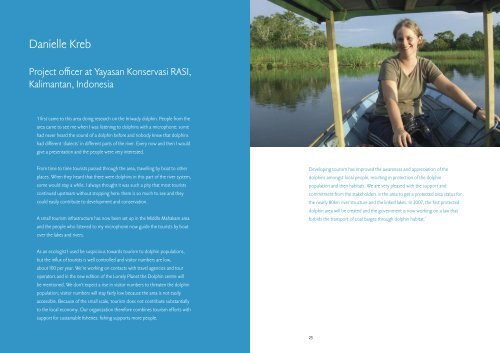OMSLAG 5.indd - IUCN
OMSLAG 5.indd - IUCN
OMSLAG 5.indd - IUCN
You also want an ePaper? Increase the reach of your titles
YUMPU automatically turns print PDFs into web optimized ePapers that Google loves.
Danielle Kreb<br />
Project officer at Yayasan Konservasi RASI,<br />
Kalimantan, Indonesia<br />
‘I first came to this area doing research on the Irriwady dolphin. People from the<br />
area came to see me when I was listening to dolphins with a microphone: some<br />
had never heard the sound of a dolphin before and nobody knew that dolphins<br />
had different ‘dialects’ in different parts of the river. Every now and then I would<br />
give a presentation and the people were very interested.<br />
From time to time tourists passed through the area, travelling by boat to other<br />
places. When they heard that there were dolphins in this part of the river system,<br />
some would stay a while. I always thought it was such a pity that most tourists<br />
continued upstream without stopping here: there is so much to see and they<br />
could easily contribute to development and conservation.<br />
A small tourism infrastructure has now been set up in the Middle Mahakam area<br />
and the people who listened to my microphone now guide the tourists by boat<br />
over the lakes and rivers.<br />
As an ecologist I used be suspicious towards tourism to dolphin populations,<br />
but the influx of tourists is well controlled and visitor numbers are low,<br />
about 100 per year. We’re working on contacts with travel agencies and tour<br />
operators and in the new edition of the Lonely Planet the Dolphin centre will<br />
be mentioned. We don’t expect a rise in visitor numbers to threaten the dolphin<br />
population; visitor numbers will stay fairly low because the area is not easily<br />
accessible. Because of the small scale, tourism does not contribute substantially<br />
to the local economy. Our organization therefore combines tourism efforts with<br />
support for sustainable fisheries: fishing supports more people.<br />
22 23<br />
Developing tourism has improved the awareness and appreciation of the<br />
dolphins amongst local people, resulting in protection of the dolphin<br />
population and their habitats. We are very pleased with the support and<br />
commitment from the stakeholders in the area to get a protected area status for<br />
the nearly 80km river structure and the linked lakes. In 2007, the first protected<br />
dolphin area will be created and the government is now working on a law that<br />
forbids the transport of coal barges through dolphin habitat.’
















